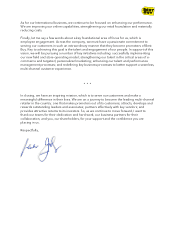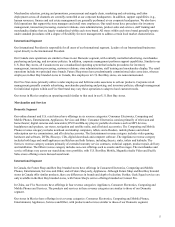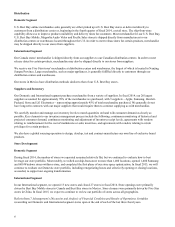Best Buy 2014 Annual Report Download - page 15
Download and view the complete annual report
Please find page 15 of the 2014 Best Buy annual report below. You can navigate through the pages in the report by either clicking on the pages listed below, or by using the keyword search tool below to find specific information within the annual report.10
Refer to Item 7, Management's Discussion and Analysis of Financial Condition and Results of Operations, for further
information regarding our strategies.
Failure to effectively manage our property portfolio may negatively impact our operating results.
As a multi-national retailer, effective management of our large property portfolio is critical to our success. We primarily secure
properties through operating leases with third-party landlords. If we fail to negotiate appropriate terms for new leases we enter
into, we may incur lease costs that are excessive and cause operating margins to be below acceptable levels. We may also make
term commitments that are too long or too short, without the option to extend. The availability of suitable new property
locations may also hinder our ability to maintain or grow our operations. Factors such as the condition of local property
markets, availability of lease financing, taxes, zoning and environmental issues, and competitive actions may impact the
availability for suitable property.
We have closed stores, and we may close additional stores or other facilities in the future. For leased property, the financial
impact of exiting a property can vary greatly depending on, among other factors, the terms of the lease, the condition of the
local property market, demand for the specific property, our relationship with the landlord and the availability of potential sub-
lease tenants. It is difficult for us to influence some of these factors. If these factors are unfavorable to us, then the costs of
exiting a property can be significant. When we enter into a contract with a tenant to sub-lease property, we remain at risk of
default by the tenant and the impact of such defaults on our future results could be significant.
Failure to effectively manage our costs could have a material adverse effect on our profitability.
Certain elements of our cost structure are largely fixed in nature. Consumer spending remains uncertain, which makes it more
challenging for us to maintain or increase our operating income. The competitiveness in our industry and increasing price
transparency mean that the focus on achieving efficient operations is greater than ever. As a result, we must continuously focus
on managing our cost structure. Failure to manage our labor and benefit rates, advertising and marketing expenses, operating
leases, other store expenses or indirect spending could severely impair our ability to maintain our price competitiveness while
achieving acceptable levels of profitability.
Our liquidity may be materially adversely affected by constraints in the capital markets or our vendor credit terms.
We need sufficient sources of liquidity to fund our working capital requirements, service our outstanding indebtedness and
finance investment opportunities. Without sufficient liquidity, we could be forced to curtail our operations or we may not be
able to pursue business opportunities. The principal sources of our liquidity are funds generated from operating activities,
available cash and liquid investments, credit facilities, other debt arrangements and trade payables. Our liquidity could be
materially adversely impacted if our vendors reduce payment terms and/or impose tighter credit limits. If our sources of
liquidity do not satisfy our requirements, we may need to seek additional financing. The future availability of financing will
depend on a variety of factors, such as economic and market conditions, the regulatory environment for banks and other
financial institutions, the availability of credit and our credit ratings, and our reputation with potential lenders. These factors
could materially adversely affect our costs of borrowing and our ability to pursue growth opportunities, and threaten our ability
to meet our obligations as they become due.
Changes in our credit ratings may limit our access to capital and materially increase our borrowing costs.
In fiscal 2014, Moody's Investors Service, Inc. maintained its long-term credit rating at Baa2, but revised its outlook from
Developing to Negative. Fitch Ratings Ltd. and Standard & Poor's Ratings Services maintained their long-term credit ratings at
BB- and BB, respectively, and each revised its outlook from Negative to Stable.
Future downgrades to our credit ratings and outlook could negatively impact our access to capital markets, the borrowing cost
for future financings and the perception of our credit risk by lenders and other third parties. Our credit ratings are based upon
information furnished by us or obtained by a rating agency from its own sources and are subject to revision, suspension or
withdrawal by one or more rating agencies at any time. Rating agencies may change the ratings assigned to us due to
developments that are beyond our control, including the introduction of new rating practices and methodologies.
Any downgrade may result in higher interest costs for certain of our credit facilities and could result in higher interest costs on
future financings. In addition, downgrades may impact our ability to obtain adequate financing, including via trade payables
with our vendors. Customers' inclination to shop with us or purchase gift cards or extended warranties may also be affected by
the publicity associated with deterioration of our credit ratings.
























